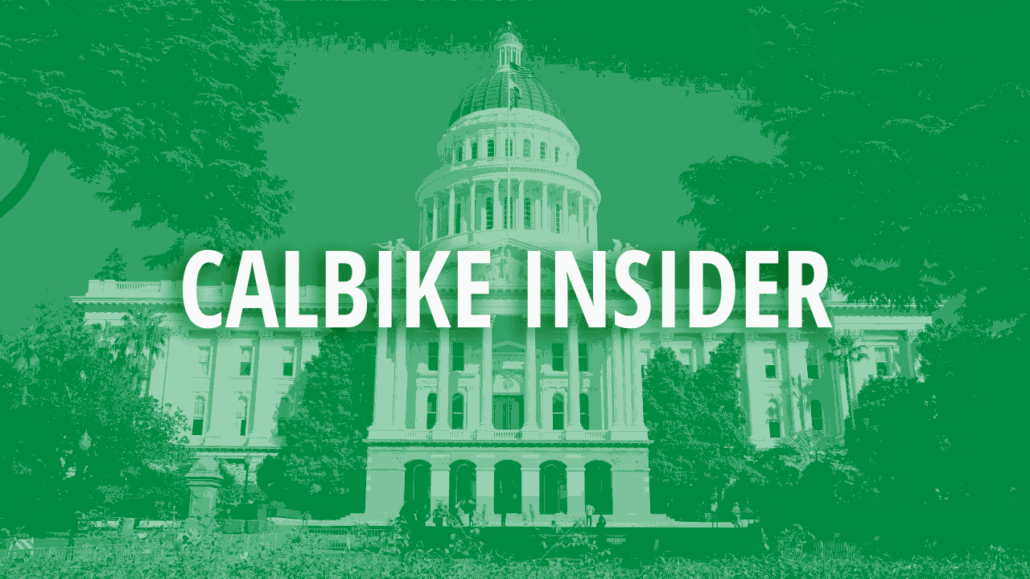A great deal of the work your CalBike staff does in Sacramento is behind the scenes. We attend technical advisory committee meetings, advise senior (and junior) staff on best practices, and nudge state agencies to advance in our direction: toward better communities where more people can experience the healthful joy of bicycling, with equity, prosperity, and inclusion as top priorities. This week we’ve been reflecting on advances at Caltrans, advocating for active transportation allocations from the budget surplus, and mourning the speed camera bill, which died in committee.
Some of our work is necessarily private, but here’s what we can tell you.
Caltrans is Making Progress
Changing a huge bureaucracy is often difficult. It’s been a slow process to transform Caltrans from an agency that safeguards the interests of cars to one that responds to our current challenges, and there is much more work still to be done.
However, under the leadership of Toks Omishakin, Caltrans has impressed us with structural changes. One great example is the creation of a high-level Division of Safety Programs and the appointment of longtime bicycle advocate Rachel Carpenter as its Chief Safety Officer. Carpenter previously worked on Livable Streets at SFMTA and she’s a regular bike commuter. The division will bring additional focus to the goal of zero traffic deaths. This should have influence over other offices within Caltrans which impact safety, such as Traffic Operations and the Division of Design.
Budget surplus provides an opportunity to fund active transportation projects
California’s May Budget Revision showed a $76 billion surplus, with $38 billion in discretionary spending. The competition for that money is fierce. It’s the source of the $600 checks that most Californians will receive, and a welcome boost to early childhood education and afterschool programs. It’s also a great source for infrastructure funding, especially since it’s a one-time boost. The competitive statewide portion of the Active Transportation Program is funded annually at about $220 million. In 2020, California communities submitted applications for $2.3 billion of projects. It desperately needs an infusion of cash.
Yet active transportation advocates had mixed reactions to a proposal from a cohort of California Transportation Commissioners with ties to the road-building industry. The commissioners asked for an incredible $2 billion infusion into the ATP. However, their intention was to derail an earlier proposal suggested by the California State Transportation Agency in its draft “Climate Action Plan for Transportation Infrastructure” that called for an ongoing increase in the ATP by taking a little bit from other programs that mostly fund highways.
Advocates promote an alternate proposal for the budget surplus
CalBike and our allies made an alternative proposal to the Budget Committees, seeking $1 billion for the ATP and an additional $1 billion for other active transportation projects, such as the 15-minute neighborhoods and bicycle highways envisioned by AB 1147.
The governor’s May revision proposed a $500 million augmentation to the ATP and $500 million for regions to implement the goals of AB 1147, although the governor’s proposal is not as visionary as that bill imagines.
This week, CalBike is advocating to win our original request of $1 billion for the ATP and $1 billion for other active transportation projects. The coalition of road builders has joined us in asking for $1 billion for the ATP, but we parted ways on the additional funding for the programs that expand highway capacity that the road builders wanted.
Whatever happens, it looks like the ATP will get a huge infusion of funds. By law, half of the funds enter the statewide competition and half are distributed to local agencies. The state’s portion of the funding will help to implement scores of projects that were unfunded in last year’s round. Also, CalBike will continue to advocate for a longer-term solution to the underfunding of the ATP. The governor’s proposed expenditures on transportation in the next fiscal year are $32.6 billion. Unfortunately, much of this is for highways and other subsidies for driving that make bicycling and walking harder. The ATP does not stand a chance to achieve its goals unless the balance of funding shifts.
CalBike endorses speed camera bill, but the Appropriations Committee does not
AB 550 proposed a pilot project to test the efficacy of speed cameras in several California cities. The bill would have required local agencies to develop guidelines for the program with strict limitations that ensured the system would not increase inequities in California. Fines would have to be low, and only charged at speeds 10 mph or more over the speed limit. Fines could not have additional fees tacked on. The car owner would get the fine, like a parking ticket. Police would not be allowed to be involved. The bill also put privacy controls in place.
The bill’s author, Assembly Member David Chiu, did such a good job addressing these equity concerns that we were excited to support it. Camera speed enforcement reduces crashes and saves lives, and it might be the only acceptable solution to scofflaw speeders on certain streets.
However, the Appropriations Committee killed the bill at its May 20 hearing. The committee didn’t offer any clues for their reason for killing this bill, but the demise of AB 550 is a loss for safe streets. CalBike supports the concept of speed safety systems. If another bill is introduced that addresses equity concerns as comprehensively as AB 550, we’ll support it.



